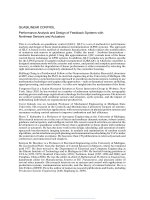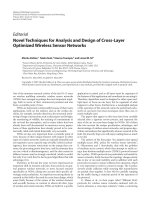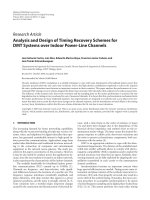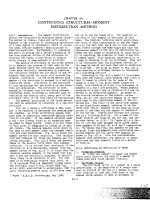Traffic Analysis and Design of Wireless IP Networks ppt
Bạn đang xem bản rút gọn của tài liệu. Xem và tải ngay bản đầy đủ của tài liệu tại đây (4.29 MB, 385 trang )
TEAMFLY
Team-Fly
®
Simpo PDF Merge and Split Unregistered Version -
Traffic Analysis and Design of
Wireless IP Networks
Simpo PDF Merge and Split Unregistered Version -
For a listing of recent titles in the Artech House Mobile Communications Series,
turn to the back of this book.
Simpo PDF Merge and Split Unregistered Version -
Traffic Analysis and Design of
Wireless IP Networks
Toni Janevski
Artech House
Boston • London
www.artechhouse.com
Simpo PDF Merge and Split Unregistered Version -
Library of Congress Cataloging-in-Publication Data
Janevski, Toni.
Traffic analysis and design of wireless IP networks / Toni Janevski.
p. cm. — (Artech House mobile communications series)
Includes bibliographical references and index.
ISBN 1-58053-331-0 (alk. paper)
1. Wireless communication systems. 2. Telecommunication—Traffic. 3. Mobile
communication systems. I. Title II. Series.
TK5103.2.J38 2003
621.382’15—dc21 2003041890
British Library Cataloguing in Publication Data
Janevski, Toni
Traffic analysis and design of wireless IP networks. — (Artech House mobile
communications series)
1. Mobile communication systems—Design and construction 2. Wireless Internet
3. Telecommunication—Traffic I. Title
621.3’8456
ISBN 1-58053-331-0
Cover design by Igor Valdman
© 2003 ARTECH HOUSE, INC.
685 Canton Street
Norwood, MA 02062
All rights reserved. Printed and bound in the United States of America. No part of this book
may be reproduced or utilized in any form or by any means, electronic or mechanical, including
photocopying, recording, or by any information storage and retrieval system, without permission
in writing from the publisher.
All terms mentioned in this book that are known to be trademarks or service marks have been
appropriately capitalized. Artech House cannot attest to the accuracy of this information. Use of
a term in this book should not be regarded as affecting the validity of any trademark or service
mark.
International Standard Book Number: 1-58053-331-0
Library of Congress Catalog Card Number: 2003041890
10987654321
Simpo PDF Merge and Split Unregistered Version -
To my wonderful sons, Dario and Antonio, and
to the woman of my life, Jasmina
Simpo PDF Merge and Split Unregistered Version -
.
Simpo PDF Merge and Split Unregistered Version -
Contents
Preface
xv
1 Introduction 1
1.1 Evolution Process 1
1.2 Why Wireless IP Networks? 2
1.3 Traffic Issues 4
1.4 Design Issues 5
2 Third Generation Wireless Mobile Communications
and Beyond 9
2.1 Introduction 9
2.2 Evolution of Wireless Communication 11
2.3 Second Generation Mobile Networks 12
2.3.1 GSM—State of the Art 15
2.4 Evolution from 2G to 3G 16
2.4.1 HSCSD 17
2.4.2 GPRS—Tracing the Way to Mobile Internet 17
2.4.3 EDGE 19
2.5 Third Generation Mobile Networks 20
2.5.1 Standardization 20
vii
Simpo PDF Merge and Split Unregistered Version -
2.5.2 UMTS 22
2.5.3 WCDMA 28
2.5.4 TD-CDMA 31
2.5.5 cdma2000 32
2.6 Third Generation Mobile Applications and Services 35
2.6.1 New Killer Applications 38
2.6.2 Real-Time Services 41
2.6.3 Nonreal-Time Services 43
2.7 Future Wireless Communication Networks Beyond 3G 44
2.7.1 All-IP Mobile Network 47
2.8 Discussion 49
References 49
3
Wireless Mobile Internet 53
3.1 Introduction 53
3.2 IP 54
3.2.1 IPv4 54
3.2.2 IP Version 6 56
3.3 Transport Control of IP Packets 57
3.3.1 TCP Mechanisms 58
3.3.2 TCP Implementations 61
3.3.3 Stream Control Transmission Protocol 62
3.4 QoS Provisioning in the Internet 63
3.4.1 MPLS 64
3.4.2 Integrated Services 66
3.4.3 Differentiated Services 69
3.5 Introduction of Mobility to the Internet 73
3.5.1 Mobile IP Protocol 74
3.5.2 Micromobility 76
3.6 QoS Specifics of Wireless Networks 83
3.6.1 Cellular Topology 83
3.6.2 Mobility 83
3.6.3 BER in the Wireless Link 85
viii
Traffic Analysis and Design of Wireless IP Networks
Simpo PDF Merge and Split Unregistered Version -
3.7 Discussion 86
References 87
4
Teletraffic Theory 91
4.1 Introduction 91
4.2 Some Important Random Processes 92
4.3 Discrete Markov Chains 96
4.4 The Birth-Death Process 100
4.4.1 Stationary System 104
4.4.2 Birth-Death Queuing Systems in Equilibrium 106
4.5 Teletraffic Theory for Loss Systems with
Full Accessibility 106
4.6 Teletraffic Theory for Loss Systems with
Multiple Traffic Types 111
4.6.1 Loss Systems with Integrated Traffic 112
4.6.2 Phase-Type Distributions 114
4.6.3 Multidimensional Erlang Formula 117
4.6.4 Priority Queuing 120
4.6.5 Error Control Impact on Traffic 123
4.7 Teletraffic Modeling of Wireless Networks 126
4.8 Principles of Dimensioning 129
4.9 Discussion 132
References 133
5
Characterization and Classification of IP Traffic 135
5.1 Introduction 135
5.2 Characterization of IP Traffic 136
5.2.1 Aggregate Internet Traffic 136
5.2.2 Internet Traffic Components 137
5.3 QoS Classification of IP Traffic 139
5.4 Statistical Characteristics 143
5.4.1 Nature of IP Traffic 144
5.4.2 Self-Similar Processes 149
Contents
ix
Simpo PDF Merge and Split Unregistered Version -
5.4.3 Statistical Analysis of Nonreal-Time Traffic 152
5.4.4 Statistical Analysis of Real-Time Services 155
5.4.5 Genesis of IP-Traffic Self-Similarity 158
5.5 Discussion 164
References 164
6
Architecture for Mobile IP Networks with
Multiple Traffic Classes 167
6.1 Introduction 167
6.2 Architecture of Wireless IP Networks with
Integrated Services 168
6.2.1 Network Architecture 169
6.2.2 Integrated Simulation Architecture 170
6.3 Conceptual Model of Network Nodes 171
6.3.1 Scheduling Schemes 173
6.4 Simulation Architecture for Performance Analysis 176
6.5 Wireless Link Model 177
6.6 Traffic Modeling 179
6.6.1 Call-Level Traffic Modeling 179
6.6.2 Packet-Level Traffic Modeling 180
6.7 Mobility Modeling 186
6.7.1 Macromobility Model 187
6.7.2 Micromobility Model 190
6.8 Performance Parameters 190
6.8.1 QoS Parameters on Call-Level 190
6.8.2 QoS Parameters on Packet-Level 192
6.8.3 Capacity 193
6.9 Discussion 195
References 196
7
Analytical Analysis of Multimedia Mobile Networks 199
7.1 Introduction 199
7.2 Analysis of Mobile Networks with Single Traffic Class 200
7.2.1 Analytical Modeling 200
x
Traffic Analysis and Design of Wireless IP Networks
TEAMFLY
Team-Fly
®
Simpo PDF Merge and Split Unregistered Version -
7.3 Analysis of Multimedia Mobile Networks with
Deterministic Resource Reservation 204
7.4 Analysis of Multimedia Mobile Networks with
Statistical Local Admission Control 208
7.4.1 Efficiency of the Mobile Network 211
7.4.2 Optimization of Mobile Networks 215
7.5 Traffic Loss Analysis in Multiclass Mobile Networks 217
7.5.1 Application of Multidimensional Erlang-B Formula
in Mobile Networks 217
7.5.2 Multirate Traffic Analysis 220
7.6 Traffic Analysis of CDMA Networks 226
7.6.1 Capacity Analysis of CDMA Network 227
7.6.2 Calculation of the Soft Capacity 233
7.6.3 Numerical Analysis 234
7.7 Discussion 236
References 237
8
Admission Control with QoS Support in
Wireless IP Networks 239
8.1 Introduction 239
8.2 System Model 240
8.3 Hybrid Admission Control 242
8.3.1 Hybrid Admission Control Algorithm 242
8.4 Analytical Frame of HAC 244
8.5 Optimal Thresholds in HAC Algorithm 253
8.6 Analysis of the Admission Control in
Wireless Networks 255
8.7 Admission Control in Wireless CDMA Networks 260
8.7.1 SIR-Based Admission Control 261
8.7.2 Load-Based Admission Control 262
8.7.3 Power-Based Admission Control 263
8.7.4 Power Control 265
8.7.5 Performance Measures for CDMA Systems 265
8.7.6 Congestion Control 266
Contents
xi
Simpo PDF Merge and Split Unregistered Version -
8.7.7 Hybrid Admission Control Algorithm for
Multiclass CDMA Networks 266
8.8 Discussion 267
References 268
9
Performance Analysis of Cellular IP Networks 271
9.1 Introduction 271
9.2 Service Differentiation in Cellular Packet Networks 272
9.3 Handover in Cellular Networks 274
9.3.1 Handover in Cellular Packet Networks 274
9.3.2 Handover Mechanisms 275
9.3.3 Analysis of Packet Losses at Handover 277
9.4 Network Model 279
9.5 Simulation Analysis in Wireless IP Networks 280
9.5.1 Handover Loss Analysis for CBR Flows 280
9.5.2 Handover Loss Analysis for VBR Flows 284
9.5.3 Handover Loss Analysis for Best-Effort Flows 290
9.5.4 Performance Analysis of Different Traffic Types
Under Location-Dependent Bit Errors 293
9.6 Discussion 295
References 296
10
Handover Agents for QoS Support 299
10.1 Introduction 299
10.2 Handover Agent Algorithm for Wireless IP Networks 300
10.2.1 Who May Initiate a Handover? 300
10.2.2 Handover Types on a Link Layer 301
10.2.3 Handover Agents 302
10.3 Routing in the Wireless Access Network 305
10.4 Location Control and Paging 310
10.5 Discovery of the Crossover Node 312
10.5.1 Crossover Node Discovery for B Flows 312
10.5.2 Crossover Node Discovery for A Flows 313
xii
Traffic Analysis and Design of Wireless IP Networks
Simpo PDF Merge and Split Unregistered Version -
10.6 Performance Analysis of the Handover Agent Scheme 314
10.7 Discussion 319
References 320
11
QoS Provisioning in Wireless IP Networks
Through Class-Based Queuing 323
11.1 Introduction 323
11.2 Wireless Network and Channel Model 325
11.3 Design of Wireless Scheduling Algorithms 326
11.3.1 Wireline and Wireless Fluid Fair Queuing 326
11.3.2 WFQ Algorithms 328
11.3.3 Service Differentiation Applied to Existing Systems 331
11.4 Wireless Class-Based Flexible Queuing 334
11.4.1 Class Differentiation 334
11.4.2 Scheduling in an Error State 338
11.4.3 Characteristics of WCBFQ 342
11.5 Simulation Analysis 343
11.6 Discussion 347
References 348
12
Conclusions 351
About the Author 355
Index 357
Contents
xiii
Simpo PDF Merge and Split Unregistered Version -
.
Simpo PDF Merge and Split Unregistered Version -
Preface
Wireless networks have penetrated almost a billion subscribers worldwide with
first and second generation mobile networks. The main service was voice, and
more recently modem-based low-rate data services. Because of the voice-
oriented traffic and circuit-switching technology, these networks are dimen-
sioned and designed using the traditional traffic theory in telecommunications.
Their design is based on high-cost centralized switching and signaling equip-
ment and base stations as wireless access points. Another technology dominated
the world in the wired local telecommunication networks: IP technology. The
transparency of the Internet Protocol (IP) to different traffic types and low-cost
switching equipment made it very attractive to operators and customers.
The third generation (3G) of mobile networks introduces wide spectrum
and high data rates as well as variety of circuit-switched and packet-based serv
-
ices. It provides IP connectivity besides the circuit switching. Future generation
mobile systems are expected to include heterogeneous access technologies, such
as wireless LAN and 3G, as well as end-to-end IP connectivity (i.e., an all-IP
network). The diversity of traffic services and access technologies creates new
possibilities for both operators and users. On the other hand, it raises new traffic
and design issues.
This book provides traffic analysis, dimensioning, quality of service (QoS),
and design aspects for wireless IP networks with multiple traffic classes.
In Chapter 2 we provide a description of existing mobile systems, installed
or standardized, from second generation (2G) towards the 2G+ and 3G mobile
systems.
Internet protocols are the main subject in Chapter 3. We consider IP pro
-
tocol version 4 and version 6, as well as the Transport Control Protocol (TCP),
which is the most commonly used protocol on the transport layer in accordance
xv
Simpo PDF Merge and Split Unregistered Version -
to OSI. We also describe mechanisms and protocols for introducing mobility
and QoS support to the Internet.
Chapter 4 models telecommunications networks and provides the basis of
the teletraffic theory (i.e., traffic theory for telecommunications).
Characterization and classification of IP traffic is the main issue in Chap
-
ter 5. Based on the statistical analysis of traffic traces from real measurements, IP
traffic is classified into two main classes, A and B, and several subclasses.
Chapter 6 proposes architectures for wireless IP networks. It also provides
traffic and mobility models that can be applied for traffic analysis.
An analytical framework for traffic analysis in mobile networks is given in
Chapter 7. We considered single-class and multiclass mobile networks. Analyses
are provided for different access technologies, such as frequency/time division
multiple access (FDMA/TDMA) and code division multiple access (CDMA).
A hybrid admission control algorithm for wireless IP networks is proposed
and discussed in Chapter 8. The proposed algorithm considers both call-level
and packet-level.
Because of the burstiness of some traffic types (e.g., video traffic) and the
random mobility of users, as well as a lack of analytical analysis in a closed form,
we perform simulation analysis. Simulation analyses of wireless IP networks
under different mobility and traffic parameters in the network are shown in
Chapter 9.
Micromobility and location management in wireless IP networks are
addressed in Chapter 10. We propose a handover scheme that locates handover
management at the base stations by using handover agents.
Chapter 11 discusses scheduling and service differentiation in wireless IP
networks. Existing solutions for wireless LANs and 3G networks are considered.
Also, we give a design proposal for scheduling in multiclass wireless IP networks
based on the traffic classification made in Chapter 5.
The main conclusions from the book are given in Chapter 12.
The material provided in this book is mainly targeted to telecommunica
-
tions students, members of corporate mobile communications research and
development departments, network designers, capacity planners, and anyone
who finds the contents of this book helpful.
xvi
Traffic Analysis and Design of Wireless IP Networks
Simpo PDF Merge and Split Unregistered Version -
1
Introduction
1.1 Evolution Process
Cellular mobile networks made unforeseen development in the telecommunica-
tions field during the last decade of the twentieth century and the beginning of
the twenty-first. Mobile communications are less pragmatic, and continue to
demand higher bandwidths and different multimedia services for the end users.
In addition, the Internet Protocol (IP) is technology that started to penetrate the
world in the 1990s, as a result of the development of the World Wide Web
(WWW) and the popularization of electronic mail (e-mail) communication on
the Internet. The Web browser was the first widespread application to provide
different multimedia services, such as browsing text and images, and streaming
audio and video. Technological development in the 1990s and 2000s made
computers smaller and smaller, thus allowing users to carry them while moving.
The integration of wireless cellular networks and the Internet becomes a fore
-
seen scenario, one that is being realized from the 3G standardization process and
initiatives for future generations mobile networks (e.g., 4G and beyond), as well
as from the introduction of mobility to the Internet, which was initially created
for hosts attached to interconnected wired local computer networks.
Considering the development of telecommunications technology, one
may distinguish among three key events (i.e., revolutions):
1. The introduction of automatic telephone exchange (at the end of the
nineteenth century);
2. The digitalization of telecommunications systems from the 1970s to
the 1990s;
1
Simpo PDF Merge and Split Unregistered Version -
3. The integration of circuit-switched connection-oriented telecommu
-
nications and packet-based connectionless Internet in the 1990s and
2000s.
The above path, in the last two steps, was also followed by mobile systems.
Hence, first generation (1G) mobile cellular systems appeared in the 1980s. It
provided only classical analog voice service. The second generation (2G) in the
1990s introduced digitalization of the communication link end-to-end as well as
additional Integrated Services Digital Network (ISDN)-based services and
modem-based data services. Data communication in 2G is provided with data
rates of maximum 9,600 bps or 14,400 bps, which depends upon coding redun
-
dancy. The third generation mobile systems appeared in the 2000s (i.e., the first
commercial systems started in 2002 in Japan and South Korea). The global ini
-
tiation for standardization of 3G was placed within the International Telecom
-
munication Union’s (ITU) International Mobile Telephony–2000 (IMT-2000),
which was created to coordinate different initiatives for 3G mobile systems from
various developed countries: for example, Universal Mobile Telecommunication
System (UMTS) in Europe and cdma2000 in the Americas. The 3G is created to
support Internet connectivity and packet-switched services besides the tradi-
tional circuit-switched ones, with data rates ranging from 144 Kbps for fast
moving mobiles to 2 Mbps for slow moving mobile users.
Future mobile networks are expected to provide end-to-end IP connec-
tivity (i.e., they are expected to be wireless IP networks).
1.2 Why Wireless IP Networks?
The answer is not straightforward, and with each attempt one can include some
-
thing either for or against them. The circuit-switched wired and wireless net
-
works (e.g., 2G cellular networks) provide QoS support with appropriate
signaling and control information. They are very well defined, robust, and
hence very expensive systems. They are created mainly for deterministic voice
service, although they can be also used for modem-based data communication.
In addition, technological development in the 1990s made computers available
for the mass market in developed countries, and the Internet gained momentum
in the past 10 years by offering different multimedia content able to be accessed
through personal computers (PCs).
In the telecommunications sector, the basic philosophy is always towards
the balance between the costs and the quality (i.e., network operators and service
providers tend to provide higher quality of service for lower costs so that end
users can buy such services). Hence, it is not only a matter of whether the tech
-
nology can support some services, but at what costs.
2 Traffic Analysis and Design of Wireless IP Networks
Simpo PDF Merge and Split Unregistered Version -
A telecommunications system is composed of two main parts: switching
part and transmission part. Switching systems may be exchanges in circuit-
switched telecommunications or routers in packet-based networks such as the
Internet. Transmission systems are wired or wireless links that interconnect the
switching systems. Also, there are links that connect users, fixed and mobile, to
the switching systems, which forms the access network.
Then, there are two main costs for the network operators:
1. Equipment and installation costs;
2. Operation and maintenance costs.
For different media types and applications the above costs are lower when
all content is carried over a single network than through different specialized
networks because of the statistical multiplexing that reduces transmission and
switching costs. Accordingly, in the early 1990s European countries began to
develop Asynchronous Transfer Mode (ATM) as a technology that would provide
a single network for different traffic types. The idea was to take the concept of
“a single socket in the wall” for telecommunication services, similar to an
electrical-power distribution network where different appliances can be plug
into a same socket. Although well-defined, ATM had high network costs, so
it mainly lost the battle with a simpler and cheaper solution. That solution is
the Internet Protocol, which is transparent to different multimedia types. Fur-
thermore, IP provides simple interconnection and maintenance of IP networks
(i.e., local area networks) as well as low-cost switching systems (i.e., IP routers).
Also, together with its main overlaying protocols, TCP and User Datagram Pro-
tocol (UDP), it provides support for different traffic types. Gaining global popu
-
larity via the WWW and e-mail, IP emerged as the clear winner over its
opponents such as the ATM concept. The Internet provided a new type of econ
-
omy in telecommunications via support of new multimedia services, as we dis
-
cuss in Chapter 3.
Regarding voice service, mobile networks have largely reached market
saturation in developed countries (e.g., European Union), so the introduction of
IP services to existing mobile networks was considered a driving force, and it
started with 2G+. The trend continued in 3G systems, which offer higher band
-
widths than 2G but lower than wireless LANs. Wireless resources are limited
over a given geographical area. Hence, the future generation of mobile networks
is considered as an integration of the existing cellular networks and wireless
LANs with added personalized mobile networks (e.g., WPAN) and broadband
radio access networks. Only end-to-end IP networks with wireless access can
accomplish such a task, and that is the answer to the question of why wireless IP
networks should be considered.
Introduction 3
Simpo PDF Merge and Split Unregistered Version -
Definition of a Wireless IP Network.
A wireless IP network is an all-IP network
with wireless access. All data, signaling, and control information are carried us
-
ing IP packets. (Note: This definition is related to this book, and other authors
may use the same term in a different manner.)
1.3 Traffic Issues
The Internet was created to be simple and transparent to different traffic types.
But, considering the QoS, Internet basically supports one traffic type for all,
which is called best-effort traffic. The creators of IP, however, have left options
for introducing multiple traffic classes via the Type of Service (ToS) field in IPv4
header format, and lately via the Differentiated Services (DS) field in IPv6 head
-
ers. Integration of IP (i.e., Internet) and telecommunication networks for voice
service highlights the QoS support in the Internet like never before. One traffic
type for all does not well suit all applications. Also, some users may be willing to
pay more for guaranteed QoS. The QoS support is especially important in wire-
less IP networks where resources are scarce and should not be wasted.
Dimensioning precedes initial network deployment. After the start of a
network, the operator should perform traffic analysis and optimization of the
network to maintain given QoS constraints. The design of a circuit-switched
network with single traffic class (i.e., voice) is carried in telecommunications by
using a traditional approach based on the Erlang-B formula. Traffic distribution
and its parameters in wireless networks depend upon user mobility, cell size, bit
rate of the wireless link (i.e., cell capacity), network load, scheduling at the base
stations (i.e., wireless access points), handover, and location management. A
multiclass environment requires network planners and designers to consider dif
-
ferent traffic parameters for different classes. Hence, packet-based multiclass
wireless networks raise new demands on the traffic analysis and network
dimensioning.
In a wireless IP network there would simultaneously exist different traffic
types, such as voice, audio, video, multimedia, and data. Applications can be
classified into real-time (e.g., voice service) and nonreal-time (e.g., e-mail and
Web browsing). Different traffic types have different characteristics. For exam
-
ple, voice service has low correlation and it is predictable. This is not the case
with the bursty traffic, such as Web or video traffic. Therefore, one should use
statistical analysis to obtain traffic characteristics. Furthermore, different traffic
types have different QoS demands. Statistical characteristics and QoS require
-
ments of different traffic types should be the main parameters for classification
of the aggregate IP traffic.
The QoS requirements may be analyzed on different time scales and dif
-
ferent levels (i.e., call-level and packet-level). However, best-effort traffic should
4 Traffic Analysis and Design of Wireless IP Networks
TEAMFLY
Team-Fly
®
Simpo PDF Merge and Split Unregistered Version -
coexist with higher-class traffic, which has QoS demands. To provide certain
quality within the given constraints on the quality measures, wireless IP net
-
works need an appropriate admission control algorithm that will admit/reject
calls depending upon the traffic conditions in the cell and its neighboring cells.
So far, most of the admission control algorithms in multiclass networks are
based only on a call-level or on a packet-level. But in heterogeneous IP networks
one may find as the most appropriate solution to use hybrid admission control
algorithms that consider call-level parameters (e.g., call blocking probabilities)
and packet-level parameters (e.g., packet loss, delay). Also, different traffic types
have different traffic parameters (e.g., bandwidth requirements, call rate, and so
forth), which requires an analytical framework for dimensioning and optimiza
-
tion of multiclass wireless networks. In some cases where an analytical approach
is not tractable, one should proceed with simulation analysis of traffic scenarios.
1.4 Design Issues
Wireless networks have their own characteristics. The two most important dif-
ferences between the wired and wireless networks are mobility of the users and
location-dependent bit errors on the wireless link. These specifics create signifi-
cantly different conditions for QoS support.
Considering the QoS support for the Internet, there are several concepts
proposed, analyzed, and implemented. First, chronologically, is the concept of
Integrated Services, which is based on the end-to-end reservation of resources.
To provide unified QoS support for different protocols, such as IP and ATM,
which were developed independently, the Multiprotocol Label Switching (MPLS)
concept was introduced. Finally, there is a Differentiated Services concept,
which specifies by definition per-hop-behaviors instead of end-to-end services.
This mechanism differentiates the aggregate traffic per class, and hence is scal
-
able. All of these mechanisms are created for wired IP networks. But, integration
of mobile networks and the Internet is a foreseen process. Therefore, QoS
mechanisms are mapped from wired to wireless access networks.
Mobile Internet is already present via existing wireless LANs and 3G
mobile networks. However, wireless LAN is based purely on the Internet princi
-
ple in wired local networks, supporting best-effort class only. On the other
hand, 3G mobile systems are a combination of circuit-switching and packet-
switching technology. Simplified, 3G gets all the features of 2G systems and
adds IP accessibility, as well as larger bandwidth than 2G cellular networks, but
smaller than wireless LANs. In the future, mobile systems are expected to
include heterogeneous access networks.
Future generation mobile networks are going to be all-IP networks; thus,
all signaling, control, and data information should be carried using IP packets.
Introduction 5
Simpo PDF Merge and Split Unregistered Version -
In such a situation an important issue at the network design level is micro-
mobility management. Mobile IP protocol is defined as a standard for macro-
mobility management (i.e., global mobility), but it is not efficient for local
mobility. Several different solutions are proposed for micromobility manage
-
ment in IP-based wireless networks, such as Cellular IP, HAWAII, and others.
There are several important design issues within the micromobility concept,
including handover scheme, routing algorithm, and location control. Handover
is a process of transiting an ongoing connection from one service area (i.e., cell)
to another, and hence, it influences the flow and the ongoing traffic in the net
-
work. Therefore, one of the main goals of the design of wireless networks is a
fast and transparent handover mechanism. It is closely related to the routing in
the wireless access network and to the location control, both functions that
should be adapted to the IP environment.
The second important characteristic of wireless networks is bit error ratio
in the wireless channels (a definition of the wireless channel is given below). In
circuit-switched cellular networks, mobile hosts measure the bit error ratio
(BER) and signal strengths and send periodic reports to the base stations. Using
the BER and signal strengths in the wireless channel, a centralized controller of
the wireless access points decides whether to initiate a handover or not. Errors in
the wireless channels influence the QoS of the affected flow(s). In wireless IP
networks we have flows with variable data rate and different QoS requirements.
Hence, service differentiation with appropriate scheduling of IP packets onto
the wireless link is a challenging problem.
By default, wired routers on the Internet today use the first-come first-serve
(FCFS) scheduling discipline. But this mechanism does not offer QoS support.
Therefore, we should implement a more advanced scheduling discipline to pro-
vide service and flow differentiation. While scheduling in wired IP networks has
reached its maturity, it is not the case with the wireless networks. Due to error-
prone wireless channels, one should propose different or adapted scheduling
mechanisms for wireless networks. There are also different proposals for design
of scheduling mechanisms in wireless IP networks, such as Idealized Wireless
Fair Queuing (IWFQ), Channel-condition Independent Fair Queuing (CIF-Q),
and Wireless Fair Service (WFS). The design issue to consider is the provision of
efficient service differentiation in a multiclass wireless IP network.
Definition of a Wireless Channel.
A wireless channel is the amount of band
-
width that is allocated to a mobile user at a given time. The bandwidth alloca
-
tion may be provided as frequency band(s), time slot(s), access code(s), or their
combination(s). It does not mean that cell capacity is divided into circuit-
switched channels. (Note: This definition is related to this book, and other
authors may use the same term in a different manner.)
6 Traffic Analysis and Design of Wireless IP Networks
Simpo PDF Merge and Split Unregistered Version -
Overall, traffic analysis and design of wireless IP networks is not so
straightforward. There are different possibilities and different solutions that can
be applied. However, each solution might enhance certain parameters and
worsen others, so there is no best single solution. In this book we provide exist
-
ing solutions to the problems, as well as propose some methods, algorithms, and
concepts that are helpful for traffic analysis and design of wireless IP networks.
Introduction 7
Simpo PDF Merge and Split Unregistered Version -
.
Simpo PDF Merge and Split Unregistered Version -









